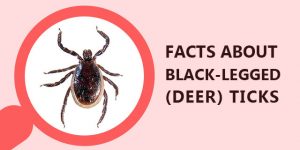Ticks are a menace and can cause sundry diseases in pets, some of which could possibly prove fatal. Besides, there is not just one but many culprits which are responsible for such diseases. One such tick is Black-legged tick which is becoming a reservoir for many ailments in cats and dogs.
Here are some interesting facts about this tick that will apprise you about its habitat, behavior and everything that you need to know about these vicious critters.
- Black-legged ticks are known so because of their black legs and orange-brown pale body.
- They are also called deer ticks because white-deer is the most common host on which they feed.
- Black-legged ticks generally hide in shrubs and grass while they wait for the passer-by Unlike lone star ticks, they don’t crawl towards their host rather cling onto them as the host comes in contact with the tick.
- These ticks can carry bacteria which are responsible for diseases like Anaplasmosis, Lyme disease, Rocky Mountain Spotted Fever and Babesiosis in canines.
- Black-legged ticks are quite commonly found in the Northeast region of the United States and are also frequent in other areas as well.
- Symptoms of black-legged borne illnesses are usually flu-like and at times are even difficult to diagnose.
- These ticks live in shaded, woody areas generally beneath leaf litters.
- Black-legged ticks eat slowly. They take almost 5 days to complete their one meal.
- Lyme disease in the eastern United States is caused by black-legged ticks.
- These ticks live about 2-3 years and they mostly spend their lives in the environment than on the host.
- It takes 24-48 hours for the black-legged tick to transmit the disease.
- They feed on the host’s blood after digging their head into the skin.
- Humans can also contract Lyme disease after being bitten by an infected deer tick.
- Lyme disease can remain dormant in the body for years and may result in neuro problems like memory loss and serious skin issues.
- They get attracted to the carbon dioxide released by pets.
Some General Tick Facts
- Ticks are arachnids just like spiders and scorpions.
- Hard ticks are found in the woods whereas soft ticks reside in caves or on birds.
- Ticks can have a lifespan of up to 200 days.
- They have 4 life stages: eggs, larvae, nymph, and
- The cocooned nymph stage of the tick can easily survive adverse climate conditions.
- You must always remove ticks with tweezers to avoid breaking his body from his dug neck inside the host’s skin. You can even opt for pain-free solution for removing ticks by using Bravecto.
- Ticks can occur year-round and thus dogs and cats must be protected using preventatives.

Still looking for more facts about ticks? Get detailed information about Unusual Facts about Ticks to protect your pets.







